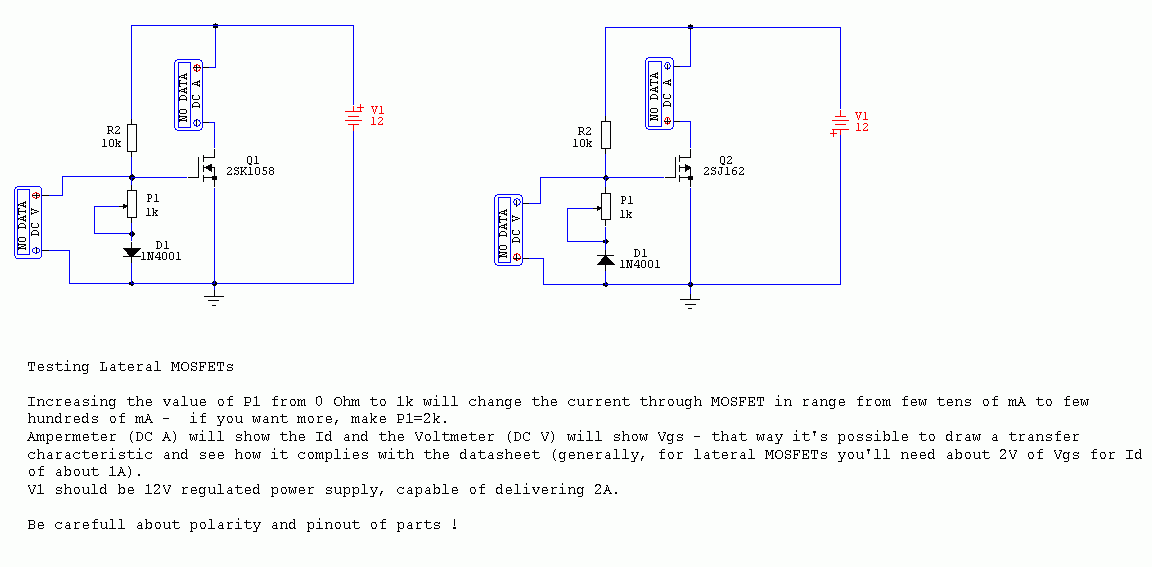I got parts from Trollet ( Figgie) a few months ago, the real thing and very nicely matched - highly recomended
hfe is very different from Vgs.My meter measures HFE - is this the same is or similar to the Vgs? can it be used for matching these?
hfe stands for current gain in bipolar transistors - it's a numerical relationship between the Ib (base current) and Ic (collector current).
Mosfet works in a different way: Vgs (voltage between gate and source) determines the current through the mosfet (Id).
This is how you match lateral mosfets (the type that is used in dh-220) - please read the whole text:

I've looked over the circuit, and I'll be damned if I can see any reason why these J49's failed! See below schematic. Q403/404 are the J49's
Check most of the resistors, larger caps, diodes, everything seems fine. With the SK134s and J49s out of circuit I get soem audio at the speakers (low and a bit distorted, but definitely present. I didn't put that trans all back in but when I started I definitely had 40 some volts DC at the output (not there with them out).
So thoughts on what might have happened to the J49s to cause them to fail? I'd hate to put a (expensive) fresh pair in only to see them fail again obviously.
An externally hosted image should be here but it was not working when we last tested it.
Check most of the resistors, larger caps, diodes, everything seems fine. With the SK134s and J49s out of circuit I get soem audio at the speakers (low and a bit distorted, but definitely present. I didn't put that trans all back in but when I started I definitely had 40 some volts DC at the output (not there with them out).
So thoughts on what might have happened to the J49s to cause them to fail? I'd hate to put a (expensive) fresh pair in only to see them fail again obviously.
Or this one if the other link didn't work https://drive.google.com/file/d/0B_Yuh1ijNVjmNEt3M3g0QWpxblE/view?usp=sharing
Hi,
this schematic is from the DH-220 manual, on page 12 in the manual you'll find the voltages for each transistor. You are in the lucky position to have one working channel and one defect channel. Check these voltages and compare them with the working one.
Maybe is only a bad solder joint, or a defect capacitor, or even a transistor at the input stage or VAS (voltage amplifying stage).
Good luck
this schematic is from the DH-220 manual, on page 12 in the manual you'll find the voltages for each transistor. You are in the lucky position to have one working channel and one defect channel. Check these voltages and compare them with the working one.
Maybe is only a bad solder joint, or a defect capacitor, or even a transistor at the input stage or VAS (voltage amplifying stage).
Good luck
Matching not required, source resistors not required
As per Radio Electronics July 1986 article about a power audio amp including 2SK134/2SJ49:
No source degeneration resistors are used in the output transistors. We found that we were able to dispense with those resistors and thus gain lower distortion .
Nor does there appear to be any need to take measures to ensure current sharing between the parallel-connected MOSFETs (by using small source resistors). In practice, if one MOSFET becomes warmer that its partner, its transconductance (gain) is reduced accordingly; thus it is temperature-compensated automatically.
Your best bet to replace 2SK134/2SJ49 is BUZ900/BUZ905, which are drop-in replacement TO-3. They can be installed in parallel without matching or source-resistors.
Ugs or Vgs (voltage between gate and source) controls the current between the drain and source of the mosfet (Id or Ids). Matching is the process that you perform in order to select parts which have same Id when same Vgs is applied.
If you parallel unmatched parts without source resistors, one of the paralleled mosfets will always conduct more current than the other and it has noticeable impact on amp's performance. You'll have to either match the mosfets or modify the circuit by introducing source resistors (which will also noticeably change the amp's performance).
Buying matched pairs from reliable source is your best option.
As per Radio Electronics July 1986 article about a power audio amp including 2SK134/2SJ49:
No source degeneration resistors are used in the output transistors. We found that we were able to dispense with those resistors and thus gain lower distortion .
Nor does there appear to be any need to take measures to ensure current sharing between the parallel-connected MOSFETs (by using small source resistors). In practice, if one MOSFET becomes warmer that its partner, its transconductance (gain) is reduced accordingly; thus it is temperature-compensated automatically.
Your best bet to replace 2SK134/2SJ49 is BUZ900/BUZ905, which are drop-in replacement TO-3. They can be installed in parallel without matching or source-resistors.
- Status
- Not open for further replies.